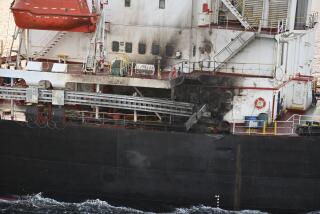Europe Spacecraft Heads for ‘Suicide’ Date With Halley’s
- Share via
DARMSTADT, West Germany — A European spacecraft is speeding toward an encounter with Halley’s Comet late today that will be so close that the craft may be destroyed in the process.
Officials with the European Space Operations Center here made the final course adjustmenTTuesday night that will send the craft, Giotto, within about 300 miles of the nucleus of the comet.
That close approach will send Giotto plunging down a dusty road that will be far more hazardous than the course traveled by two Soviet spacecraft, Vega 1 and Vega 2, both of which were slightly damaged.
Giotto will be 10 times closer to the dusty nucleus than either of the Soviet probes, although it has more protection in the form of a double-shield designed to absorb the energy from dust particles.
The spacecraft and the comet will pass each other at more than 150,000 m.p.h
Jean-Paul Paille, a spokesman for the European Space Agency, said Giotto is on schedule and should make its closest approach to Halley at 4:02 p.m. Thursday, Pacific time.
“Everything is working perfectly,” Paille said.
Officials with the European Space Agency expect the dust to begin hitting the spacecraft’s fragile solar collectors at least an hour before the closest encounter, but batteries aboard the craft should continue providing power needed to run the instruments and transmit data and photographs back to Earth.
Even if the craft is destroyed, as some scientists expect, it should be able to send some of those photographs and other data back before it is wiped out.
Scientists hope such information will eliminate confusion over what was actually seen by the two Soviet probes last week.
Most of the scientists who were in Moscow for those encounters have moved here, and there is some debate among them over whether the pictures sent back by the Soviet probes actually showed the comet’s nucleus--one of the most important targets among the five spacecraft sent to Halley’s Comet.
“I’m pretty sure we saw the nucleus,” said John Brandt, head of the astronomical laboratory at the Goddard Space Flight Center in Greenbelt, Md. Other researchers, he said, believe photos from the two Vegas simply show the dust and gases that surround the nucleus.
Roald Sagdeyev, director of Moscow’s Space Research Institute, is to formally present the results of the Soviet probes here today.
More to Read
Sign up for Essential California
The most important California stories and recommendations in your inbox every morning.
You may occasionally receive promotional content from the Los Angeles Times.













